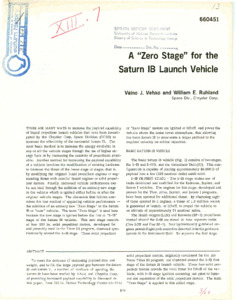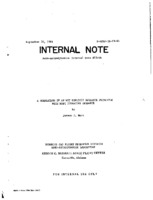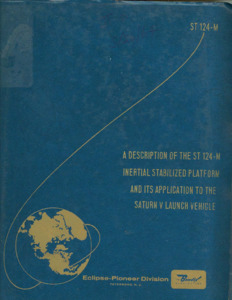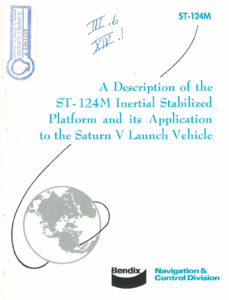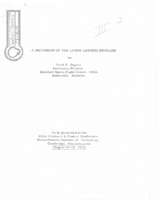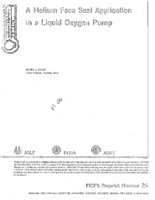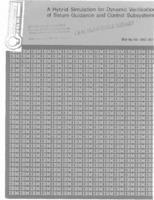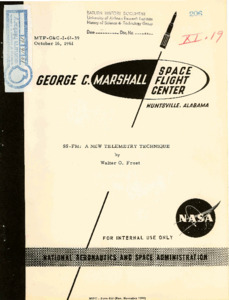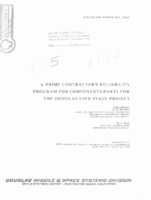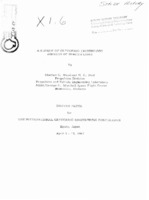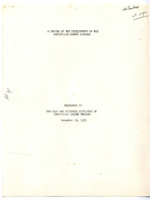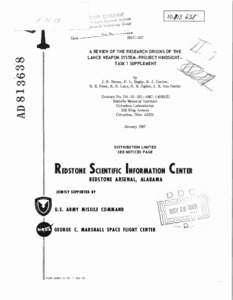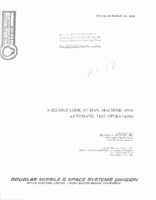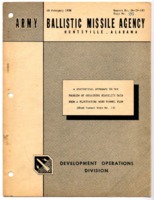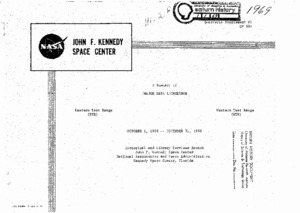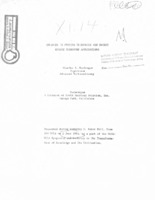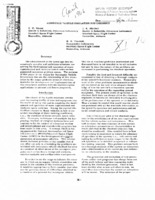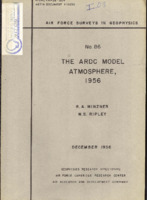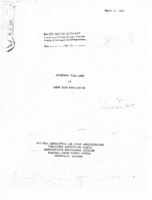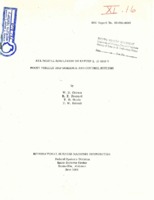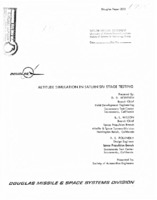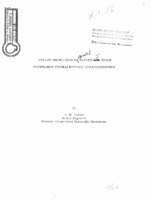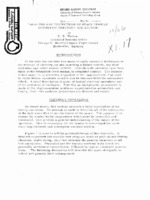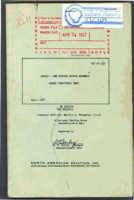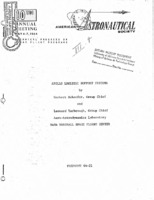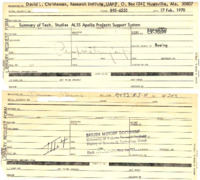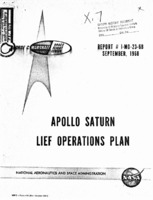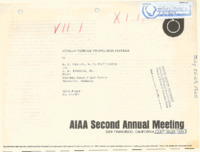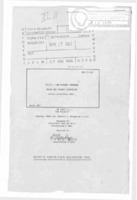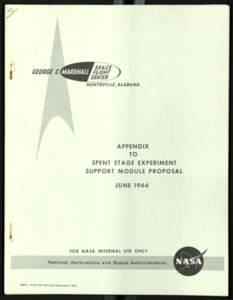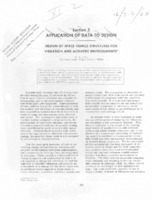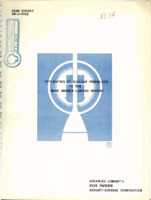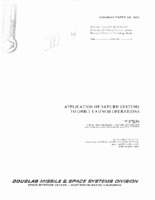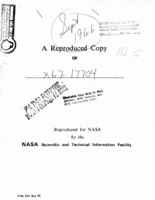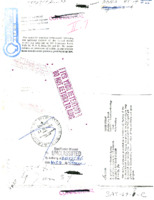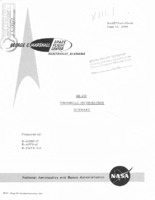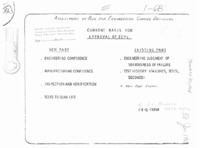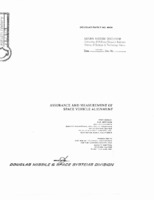
Browse Items (192 total)
Sort by:
-
"A 'Zero Stage' for the Saturn IB Launch Vehicle."
To meet the demands of increasing payload size and weight, and to fill the large payload gap between the Saturn IB and Saturn V, a number of methods of uprating the Saturn IB have been studied by NASA and Chrysler Corp. of providing increased payload capability is discussed in this paper. Four 120 in. United Technology Center UA-1205 solid propellant motors, originally developed for the Air Force Titan III program, are clustered around the S-IB first stage of the Saturn IB launch vehicle. These four solid propellant motors provide the total thrust for liftoff of the vehicle, with S-IB stage ignition occurring just prior to burn-out and separation of the solid propellant motors. The term "Zero Stage" is applied to this added stage. -
"A Comparison of an MIT Explicit Guidance Principle with MSFC Iterative Guidance."
From the summary: "Both [guidance] schemes steer toward a specified end point. The MIT scheme uses thrust to cancel out the effective gravity, a nonlinear term, which may be inefficient in certain cases. The MSFC scheme is more closely connected with calculus of variations and optimization theory in a reasonable degree of approximation." -
"A Description of the ST 124-M Inertial Stabilized Platform and its Application to the Saturn V Launch Vehicle."
This report is a description of the ST124-M inertial stabilized platform system and its application to the Saturn V launch vehicle. It is a summary report providing the system concept and not a theoretical presentation. Mathematical equations were included only where necessary to describe the equipment; however, the detail derivations supporting these equations were not presented since this was not the theme of the paper. -
"A description of the ST-124M inertial stabilized platform and its application to the Saturn V launch vehicle."
This report is a description of the ST-124M inertial stabilized platform system and its application to the Saturn V launch vehicle. It is a summary report providing the system concept, and not a theoretical presentation. Mathematical equations were included only where necessary to describe the equipment; however, the detailed derivations supporting these equations were not presented since this was not the theme of the paper. -
"A Discussion of the Lunar Landing Problem."
Digesu worked in the Astrionics Division of MSFC. This paper was presented at the AIAA Guidance & Control Conference, Massachusetts Institute of Technology, Cambridge, Massachusetts, August 12-14, 1963. -
"A Helium Face Seal Application In a Liquid Oxygen Pump."
Presented at the Fourth International Conference on Fluid Sealing held in conjunction with the 24th annual meeting in Philadelphia, May 5-9, 1969. -
"A Hybrid Simulation for Dynamic Verification of Saturn Guidance and Control Subsystems."
This paper presents a discussion of a hybrid simulation used to dynamically verify the Saturn Guidance and Control subsystems. First, the Saturn vehicle is briefly described to provide background information. The Instrument Unit (IU) is considered in more detail to give a proper setting for the Guidance and Flight Control (G and FC) discussion that follows. After a brief description of the actual G and FC System operation, simulation models of the G and FC components are considered in detail. This is followed by a discussion of the model assignment to a particular computer (digital or analog) and justification for making that assignment. Finally, results of the AS-204/LM1 hybrid simulation studies are briefly considered with mention of the actual flight data. -
"A new telemetry technique."
A technique new to telemetry is discussed which promises to alleviate an enigma facing the telemetry engineer : How to adequately transmit the avalanche of vibration and other wideband data desired in the development phase of large missiles and launch vehicles. The data channels are stacked in the frequency spectrum as single sideband subcarriers which frequency modulate the RF carrier. The system design utilizes to advantage the statistical properties of vibration data to achieve maximum data transmission efficiency from the available RF carrier deviation. However, in contrast to proposed statistical predigestion techniques, the data is transmitted in raw form. -
"A Prime Contractor's Reliability Program for Components/Parts for the Douglas S-IVB Stage Project."
This paper, presented at the fifth annual Reliability and Maintainability Conference in New York City, contains a "prime contractor's reliability program for components/parts for the Douglas S-IVB stage project." These parts include special flight critical items and their complementary reliability engineering program plan is outlined in this paper. -
"A Review of Cryogenic Technology Aspects of Space Flight."
This paper was presented at the International Cryogenic Engineering Conference in Kyoto, Japan. It details the use of cryogenic technology in rocketry and how its usage created "many new techniques and deeply stimulated many fields of cryogenic technology." -
"A Review of the Development of the Huntsville Campus Library."
Prepared by Librarian Christel L. McCanless and presented to the Arts and Sciences Committee on Huntsville Degree Program. The document includes a review of library materials and an outline of future plans, including comparisons to collections at other universities. -
"A review of the research origins of the LANCE weapon system -- Project hindsight -- Task 1 supplement."
This report includes a discussion of 57 research and exploratory development events that have been identified as contributing significantly to LANCE. Forty-six of these are research events. Eight of the research events deal with LANCE aerodynamics, four with propulsion, 24 with solid-state components used in the guidance and control system,and 10 with the research origins of the materials and manufacturing processes used in LANCE. In addition, 11 exploratory development events are identified. The principal concern of this study has been the identification of further research origins of LANCE and the 46 documented events are its major product. A further concern and obligation of this study has been to provide HINDSIGHT with some additional data on the research phenomenon including some further observations on the nature and route of research utilization.; FOREWORD: The purpose of this report is to present a survey of fundamental research contributing to the successful development of the LANCE weapon system. Included in this report are discussions of research inputs to a number of LANCE systems and technology areas. The circumstances of these research contributions to LANCE are discussed. The implications of these examples of research utilization are analyzed and some general observations and conclusions on the research payoff phenomena are given. This report was requested by the Army Missile Command as a supplemental contribution to Project HINDSIGHT.; Contract No. DA-01-021-AMC-14693(Z).; Battle Memorial Institute ,Columbus Laboratories.; RSIC-627.; Includes letter from W. Metscher, Lt. Col. to Mr. David L. Christensen dated March 14, 1969. -
"A Second Look at Man, Machine, and Automatic Test Operations."
A summary found following the errata page reads: "This paper presents a second look at the subject of the man-machine relationship in automatic test operations. 'Man, Machine, and Automatic Test Operations' was presented by the writer at Battelle Memorial Institute in November of 1963...It is the purpose of this second look at the man-machine interface to pinpoint those concepts which have proven their worth with time and those concepts which have proven to be weak, and as a result modified with time." This paper was prepared by George F. Meister, Jr. -
"A summary of major NASA launchings" between October 1st and December 31st, 1968.
This is the first Quarterly Supplement to the October 1968 edition of GP 381, ''A Summary of Major NASA Launchings (Eastern Test Range and Western Test Range)." This Supplement covers the period from October 1 to December 31, 1968. Two additional Quarterly Supplements will be issued during 1969. Each of these will list those major NASA launchings occurring during the three-month period it covers. The basic publication will be revised and reissued, incorporating the information contained in the Supplements, as well as covering the final three-month period, subsequent to October 1, 1969. William A. Lockyer, Jr. -
"Advances in Pumping Technology and Rocket Engine Turbopump Applications."
Presented by Charles A. MacGregor, Supervisor, Advanced Turbomachinery during Workshop D, Royce Hall, Room 160 at UCLA on 2 June 1964, as a part of the NASA-UCLA Symposium and Workshop on the Transformation of Knowledge and Its Utilization. The introduction notes, "This report is divided into two general parts. The first part is a description of turbopumps for liquid rocket engines as they exist today. For completeness and understanding, some background information is included on why turbopumps have evolved to their present configurations. The second part suggest portions of this effort that may have some applicability to the general economy." -
"Aerospace Vehicle Simulation and Checkout."
Paper by J. W. Moore and J. R. Mitchell, Quality & Reliability Assurance Laboratory, Marshall Space Flight Center, and H. H. Trauboth, Computation Laboratory, Marshall Space Flight Center. The paper summary notes, "The advancement of the space age into increasingly complex and ambitious missions requiring the development and operation of more sophisticated and intricate launch vehicles has generated numerous problem areas. The purpose of this paper is to define the Aerospace Vehicle Simulation; discuss the relationship of this simulation to the major problem areas of checkout; describe the development and implementation of this simulation system; indicate multidiscipline applications to present and future programs." -
"Air Force Surveys in Geophysics: The ARDC Model Atmosphere, 1956."
This paper presents a "realistic model of atmospheric properties based on reliable observations and current theories" according to the abstract found on page xv. This 1956 ARDC model was meant to be used as the "basis for engineering and design work performed." -
"Alignment Tool Aids in Large Tank Fabrication."
Includes the clipping "Clamping Tool Aligns Odd-Shaped Sections for Welding" from <i>Design News</i>, September 4, 1963, written by Margaret A. Maas. -
"All Digital Simulation of Saturn I, IB, and V: Boost Vehicle and Guidance Control Systems."
The introduction notes, "The Saturn V launch vehicle is being developed by the National Aeronautics and Space Administration's George C. Marshall Space Flight Center for Project Apollo; Saturn I and Saturn IB vehicles are providing the early testing and support for Project Apollo. The nerve center of the Saturn is its guidance and control system. An airborne digital computer provides the link which closes both the guidance and control loops,making verification of the flight computer program of vital importance. During a powered flight this onboard digital computer program can be divided into four major parts:a) guidance, including navigation, b) control, c) vehicle sequencing, and d) computer telemetry." -
"Altitude Simulation in Saturn SIV Space Testing."
This paper was presented to the Society of Automotive Engineers. The abstract reads, "The Douglas Aircraft Company has been involved in testing the Saturn SIV stage at the Sacramento Test Center for the past two years. The propulsion system for the SIV stage consists of six (6) Pratt & Whitney Aircraft Company rocket engines which are designed specifically for high altitude start and operation. During static firing tests of this engine at sea level, a steam jet ejector in combination with a diffuser, are used to simulate altitude conditions. The intent of this paper is to examine the performance of this altitude simulation system, and to discuss problems encountered in making it operational." -
"Analog Simulation of Saturn S-IB Stage Propulsion System Dynamic Characteristics."
This copy has handwritten notes that change the title to read, "Analog Simulation of Uprated Saturn I Stage Propulsion System Dynamic Characteristics." The abstract notes, "The purpose of this paper is to present the techniques and logic employed in the development of an analog computer model to simulate Saturn IV first stage propulsion system dynamic characteristics. Restraints, problem areas, and major assumptions are included." -
"Apollo - LEM Docking Drogue Assembly Static Structural Test."
This document contains the tests and test results from structural tests performed on the Apollo LEM docking drogue assembly between January 11, 1967 and February 15, 1967. The document contains various graphs, diagrams, and images pertaining to the tests. -
"Apollo Logistic Support Systems."
According to an abstract found on the page following the title page, this paper includes "one possible conceptual definition of an early Apollo Logistics Support Systems (ALSS) is presented and various payloads for the system are briefly discussed. " It also discusses the Lunar Mobile Laboratory (MOLAB) and other considerations for a lunar scientific mission. -
"Apollo Logistics Support System (ALSS) Payloads Summary Report."
This report includes a summary of the major tasks performed by the Apollo Logistics Support System Payloads with an emphasis on the Lunar Mobile Laboratory (MOLAB). -
"Apollo Saturn LIEF Operations Plan."
This paper identifies the support functions performed by MSFC through the Launch Information Exchange Facility (LIEF) during the Apollo Saturn Mission Operations and other facilities required to carry out these functions. It also identifies mission specific documents required for operation. Note that page 20 is missing. -
"Apollo Vehicle Propulsion Systems."
This paper discusses the propulsion requirements for various stages of the Apollo vehicles and the development of these engines. -
"Apollo-LEM Docking Combined Probe and Drogue Assemblies Static Structural Test."
This document contains the test technical report and results for the LEM docking probe and drogue assemblies to demonstrate that the assemblies would sustain enough load to capture latch. The document contains various graphs, diagrams, and images from testing. The final page contains a note that page no. A-139 is missing from the report. -
"Application of Data to Design: Design of Space Vehicle Structures for Vibration and Acoustic Environments."
According to the abstract, this paper discusses the need for a uniform design approach throughout the aerospace industry for space vehicle structural vibrations in order to keep pace with improvements in environment definition and testing. -
"Application of Nuclear Propulsion to the Mars Manned Landing Mission."
This report has been prepared to provide Aerojet management and the interested NASA offices with nuclear propulsion decision aid data. The primary intent of these analyses is to evaluate potential space missions which may utilize nuclear propulsion in an effort to determine the most desirable characteristics of a nuclear propulsion system. -
"Application of Saturn Systems to Orbit Launch Operations."
Presented at the AIAA/AAS Stepping Stones to Mars Meeting, this paper compares the "payload velocity spectrum for existing and future missions" with Saturn V capabilities. -
"Application of the Saturn V Launch Vehicle to Unmanned Scientific Exploration of the Solar System."
According to the foreword, "This paper presents the results of a twelve-week mission and systems analysis of a combined Jupiter orbiter/solar probe mission utilizing the Saturn V launch vehicle." -
"Approach in Achieving High Reliability for Saturn Class Vehicles."
This paper focuses on an approach for achieving high reliability within the Navigation, Guidance, and Control systems of the Saturn class launch vehicles. -
"Army Participation in the National Satellite and Space Program."
This paper, which was presented at a Semi-Annual Meeting of the American Rocket Society, traces the role of the United States Army in national space activities. Incorporated in the report are photographs illustrating the evolution of the satellite and space program. -
"AS-203 Technical Information Summary."
"This report outlines, through a series of sketches with accompanying text, the general features of the SA-203 Launch Vehicle and information on launch preparation, the launch facility and mission peculiar experiments." -
"Assessment of Risk for Engineering Change Decisions."
This document includes the current basis for approval of ECPs, fatigue life after stress reduction, and other probability and comparative risk assessments. On the first page there is an inscription, "By E.L. Bombara NASA-MSFC." -
"Assurance and Measurement of Space Vehicle Alignment."
Prepared by A. W. Dryden, Quality Engineer, Quality Engineering, Reliability Assurance, Space Systems Center, Douglas Aircraft Company, Inc., Huntington Beach, California. Presented to the 21st Annual Technical Conference for the American Society for Quality Control, Chicago, Illinois. 30 May to 2 June 1967. -
"Automated PCM Data Processor Theory of Operation."
Includes a blueprint of DDAS System Block Diagram.
